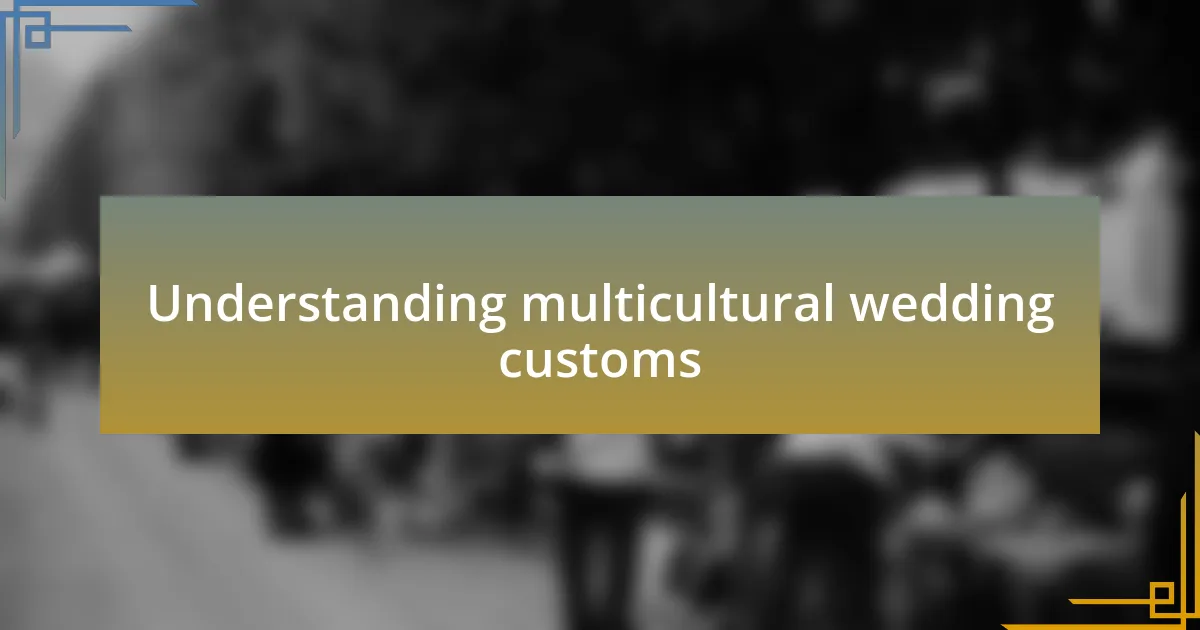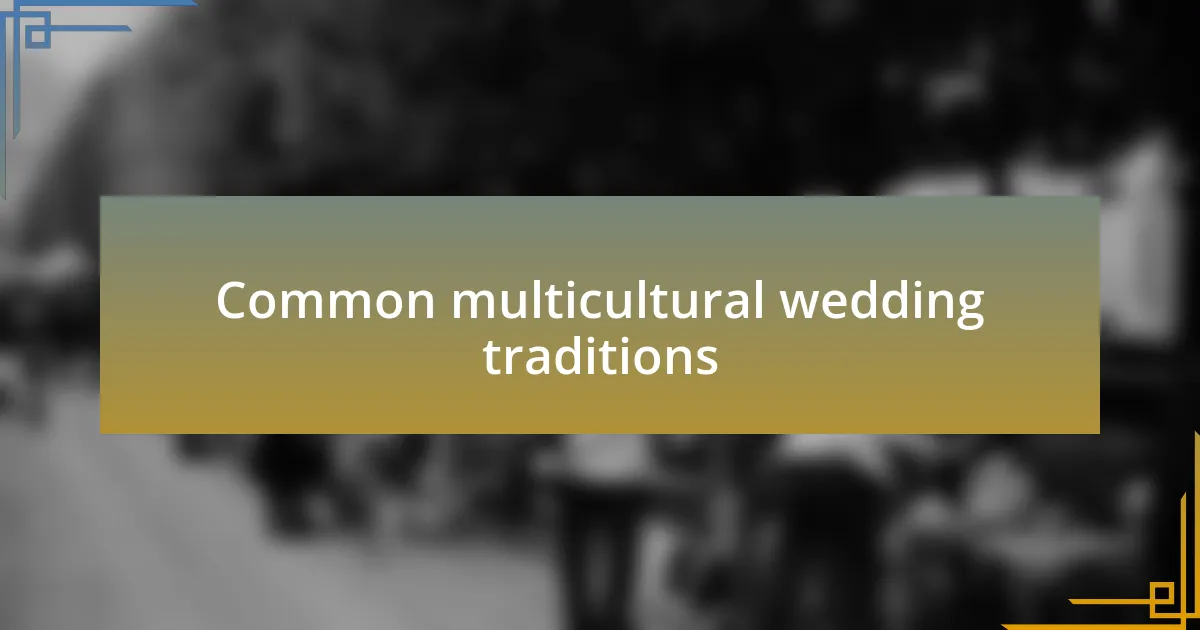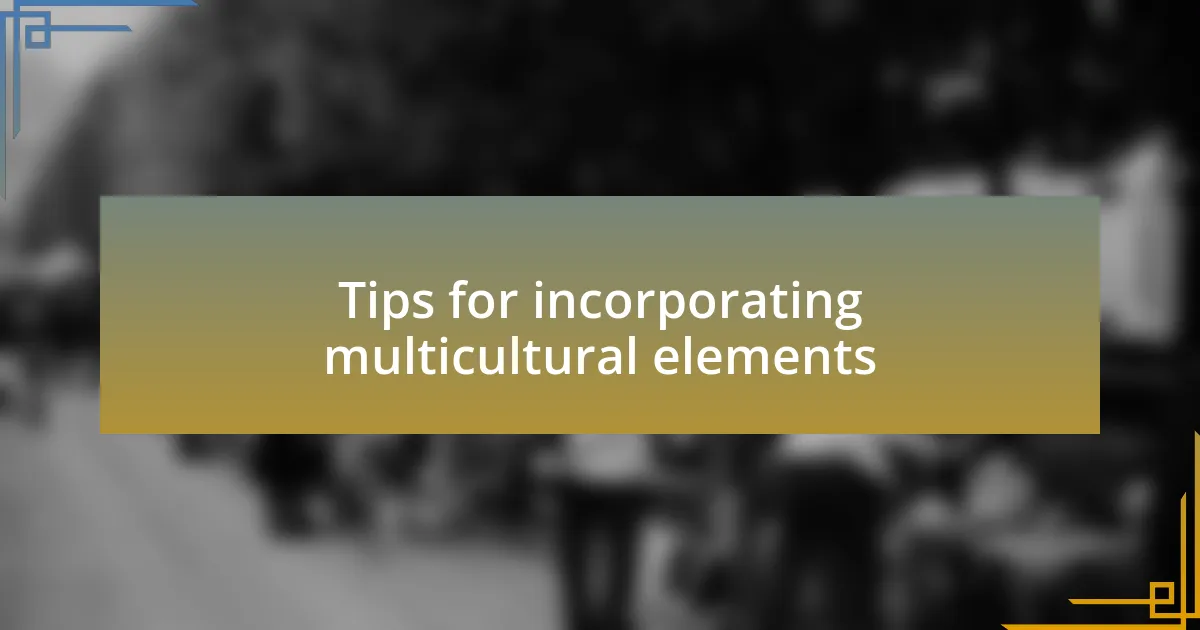Key takeaways:
- Multicultural weddings blend diverse traditions, enhancing emotional connections through customs like multi-language vow exchanges and cultural artifact sharing.
- Food serves as a metaphor for love and unity, showcasing the richness of different culinary backgrounds during celebrations.
- Incorporating elements from both cultures, such as attire and ceremony practices, fosters inclusiveness and personalizes the wedding experience.

Understanding multicultural wedding customs
When I first attended a multicultural wedding, I was struck by how different traditions blended seamlessly together. It made me wonder—how does one tradition enhance another? For instance, during the ceremony, I witnessed the beautiful fusion of Indian henna rites with Western white-dress customs. The sight of intricate designs on the bride’s hands, paired with elegant lace, created a unique tapestry of love and culture.
One aspect that particularly moved me was the exchange of vows in multiple languages. Each language carried the couple’s unique background and filled the room with deep emotion. Have you ever experienced that moment when words transcend their meaning and resonate with your heart? I felt an immediate connection not only to the couple but to their families and cultures, as words from diverse traditions intertwined into a shared commitment.
Exploring the food at these weddings is an adventure unto itself. Imagine savoring a spicy Indian curry while enjoying delicate pastries from a French patisserie—all designed to celebrate the couple’s journeys. As I indulged in each bite, I realized how food served as a metaphor for love: diverse, rich in history, and more meaningful when shared. Isn’t it fascinating how culinary traditions can unite people in joyous celebration?

Common multicultural wedding traditions
One common tradition I encountered at multicultural weddings is the unity candle ceremony. During one particularly memorable event, the couple lit a candle together, symbolizing the merging of their lives and families. Each flicker of the flame seemed to embody their shared hopes and dreams. Have you felt that electrifying moment when two distinct paths come together as one? It’s a powerful visual representation of love and commitment that resonates deeply.
Another remarkable tradition I observed was the sharing of cultural artifacts. At one wedding, the bride and groom presented their families with items representing their heritage—like a traditional Persian rug and a unique African mask. As I watched the joyful exchanges, it struck me how these objects told stories of their ancestors, cultures, and the love that had nurtured them. Doesn’t it make you think about the importance of honoring one’s roots even while forging a new path together?
In the reception, I’ve seen couples embrace the dance traditions of both cultures, bringing their guests together on the dance floor. One unforgettable moment was when the bride, dazzled in her colorful sari, led a lively Nigerian dance that had everyone laughing and joining in. The contagious joy of that shared experience reminded me how dance can break barriers, uniting people in celebration without the need for words. Have you ever lost yourself in dance, feeling connected to those around you? It truly exemplifies how multicultural weddings can foster an atmosphere of unity and joy.

My personal experience with customs
I recall a beautiful wedding where the bride’s family performed a traditional tea ceremony, which symbolized respect and gratitude. Watching the couple kneel to serve tea to their elders created a profound sense of reverence in the room. Have you ever witnessed such a heartwarming act of honoring family traditions? That moment lingered with me long after the celebration.
At another wedding, I had the opportunity to partake in a “jumping the broom” ritual. My curiosity peaked as the couple gracefully jumped over the broom, a symbol of sweeping away the past and welcoming a new life together. It felt exhilarating to join everyone as we cheered for them, akin to stepping into a joyful new beginning. What can be more uplifting than witnessing a couple take such an exuberant leap into their future?
I’ve also experienced a fusion of cuisines that reflected both sides of the family. At one reception, the tables were a delightful parade of flavors, featuring Indian curries alongside Italian pasta. I vividly remember savoring a spicy samosa while sharing laughs with guests unfamiliar with those vibrant tastes. How can food not evoke feelings of connection and celebration? It’s not just about nourishment but about sharing joyful experiences through culinary heritage.

Tips for incorporating multicultural elements
When thinking about incorporating multicultural elements into a wedding, I suggest starting with open dialogues between families. For instance, during my friend’s wedding planning, they hosted a series of family meetings where traditions from both sides were shared. This approach not only fostered understanding but also built excitement as everyone contributed ideas. Have you imagined how bonding over these customs can deepen family ties?
Another effective strategy is to blend traditional attire elements. I’ve often seen couples creatively integrate garments that reflect their heritage, like wearing a colorful sari alongside a classic tuxedo. It adds a stunning visual dynamic while honoring their roots. Doesn’t it make the celebration feel more personal and unique when both cultures visibly come together?
Finally, consider incorporating multilingual elements into your ceremony or invitations. I once attended a wedding where key phrases were spoken in several languages, which truly elevated the sense of community and inclusiveness. Hearing “I do” in multiple languages was both moving and memorable. Isn’t it wonderful to think that language can be a bridge connecting diverse backgrounds?